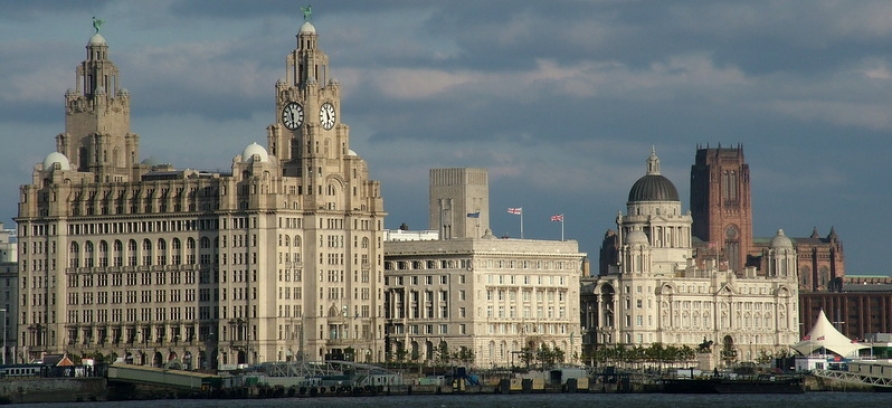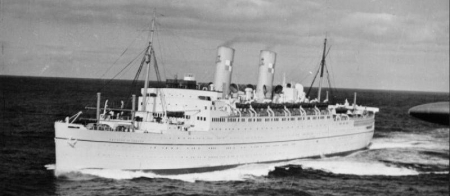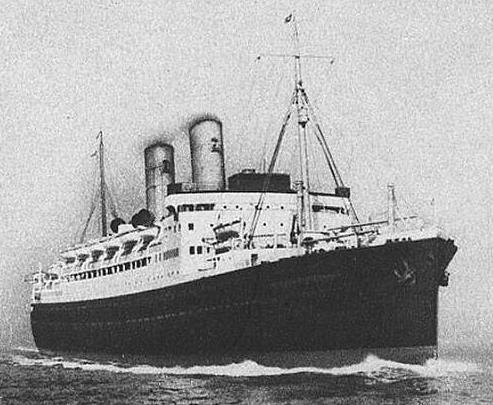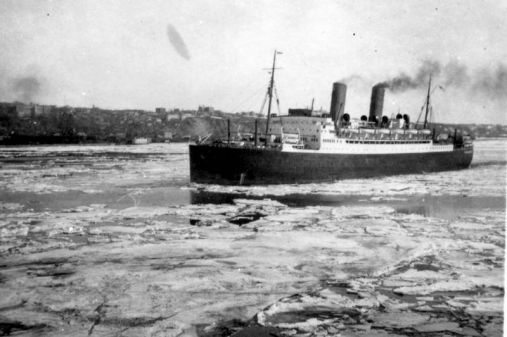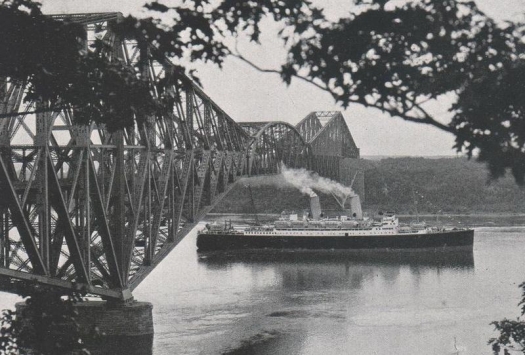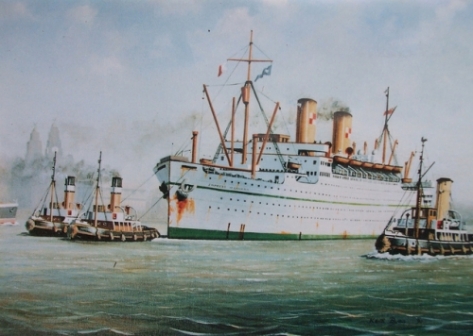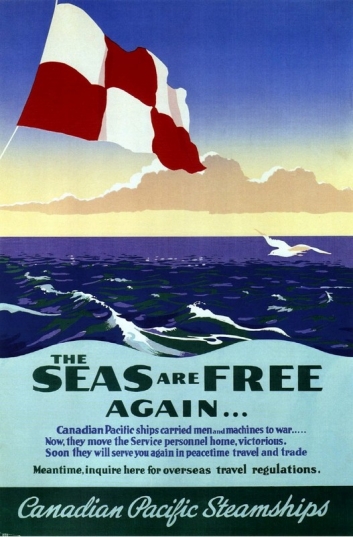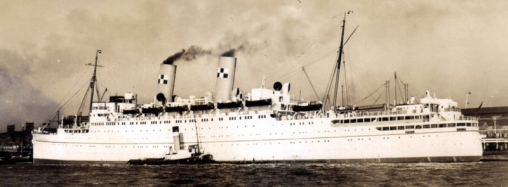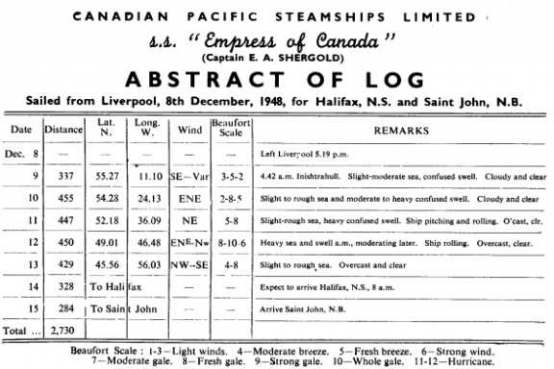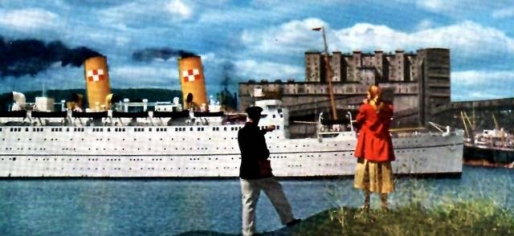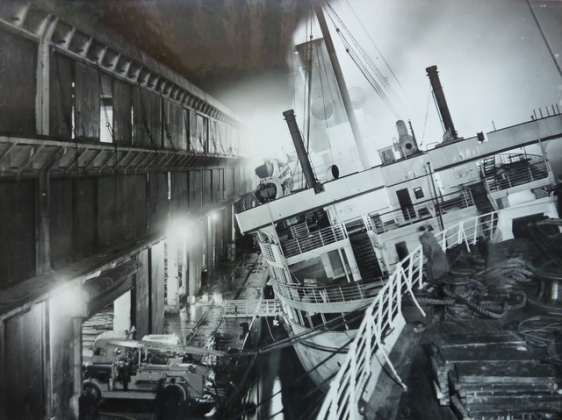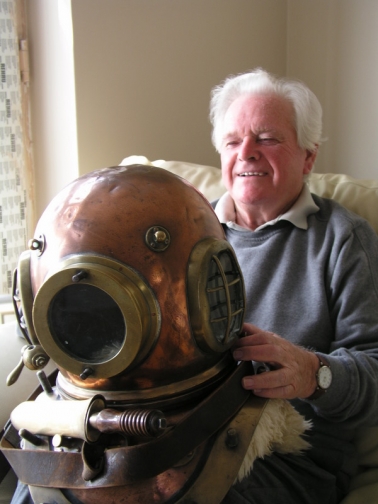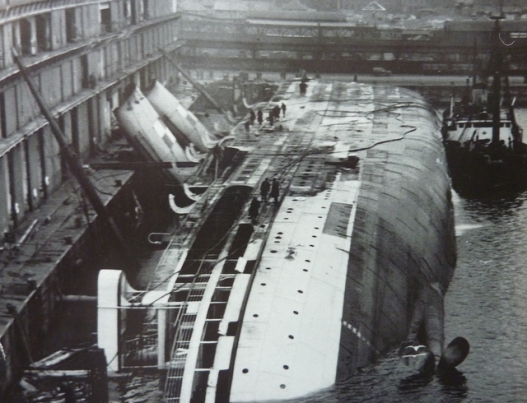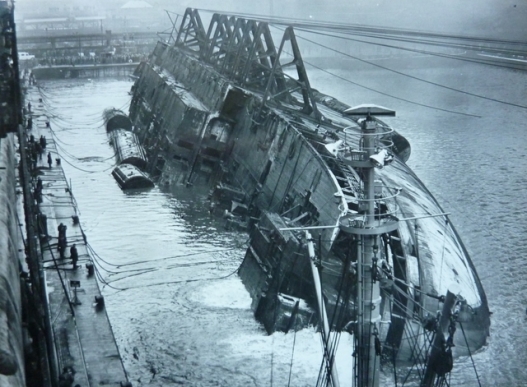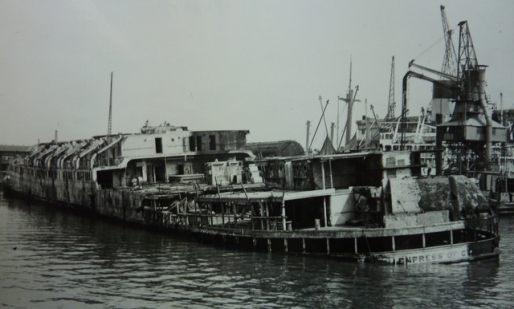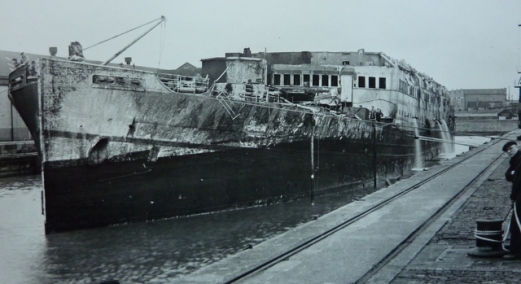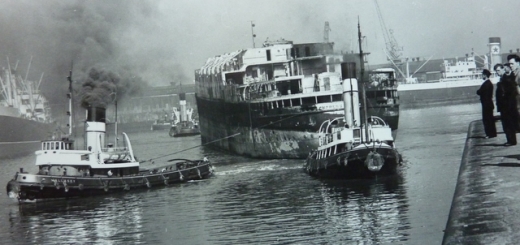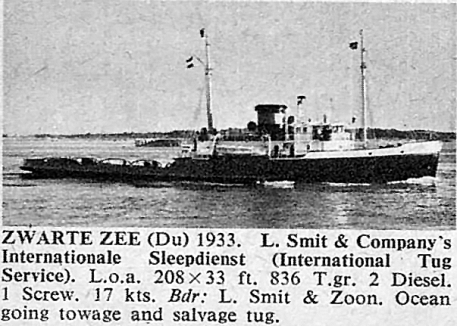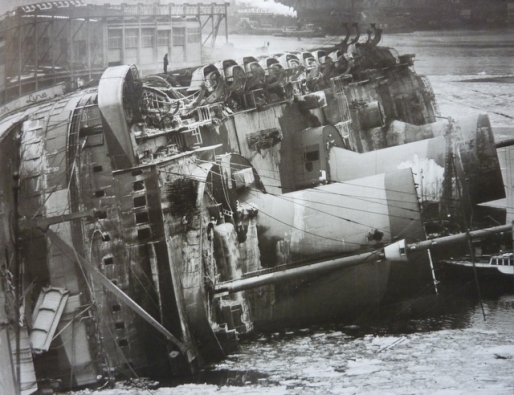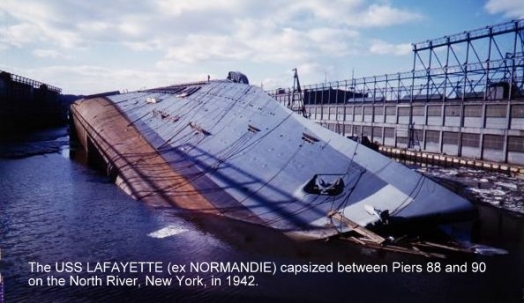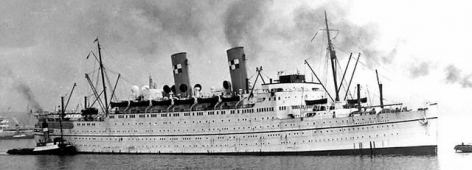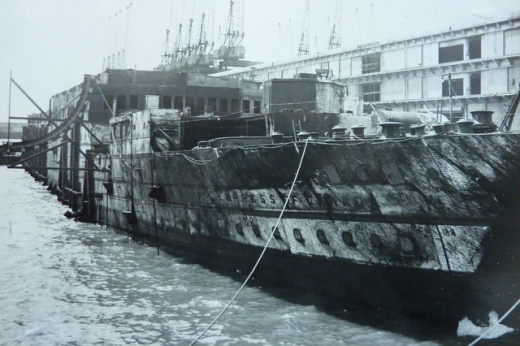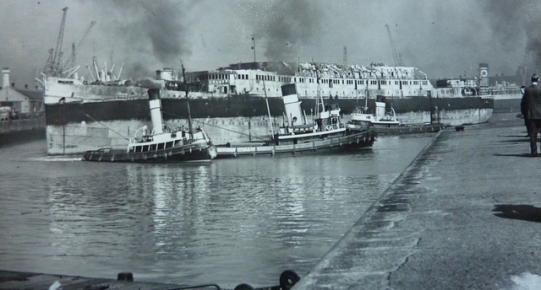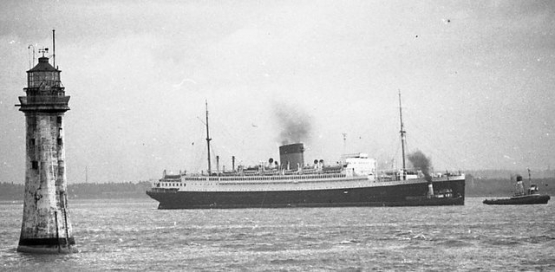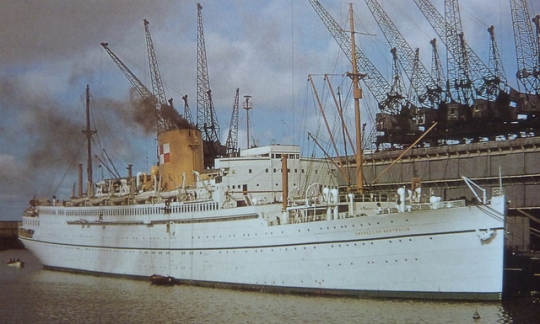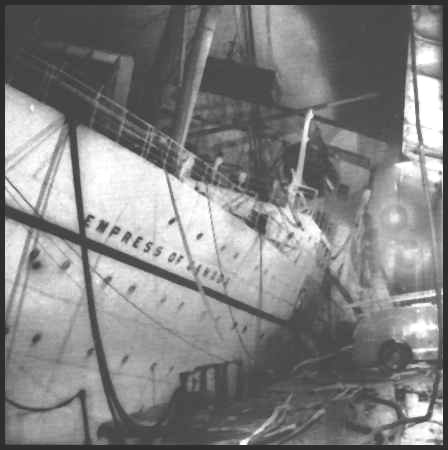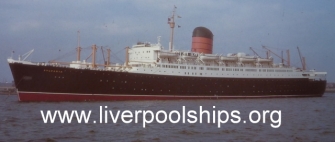THE CANADIAN PACIFIC LINER 'EMPRESS OF CANADA' WAS DESTROYED BY FIRE IN THE GLADSTONE DOCK AT LIVERPOOL ON 25th JANUARY 1953.
The EMPRESS OF CANADA (ex DUCHESS OF RICHMOND) at full speed
The EMPRESS OF CANADA was launched as the DUCHESS OF RICHMOND on 18th June 1928, and sailed on her maiden voyage from Liverpool on 26th January 1929; this taking the form of a six-week cruise to the Atlantic Islands and the West Coast of Africa. Amongst her passengers were the Chief Scout, Lt. General Sir Robert Baden-Powell, and Lady Baden-Powell. The new Duchess could carry 580 passengers in cabin-class, 480 in tourist-class and 510 in third-class, with a crew of 510.
The DUCHESS OF RICHMOND in her original form ______________________________________________
EMPRESS OF CANADA (ex DUCHESS OF RICHMOND) built by John Brown & Co. Ltd. at Clydebank in 1929. Yard No: 523 Official Number: 160631 Signal Letters: G S V R Gross Tonnage: 20,022, Nett: 11,238 Length: 600ft Breadth: 75.1ft Owned by the Canadian Pacific Railway Company (Canadian Pacific Steamships - Managers) 6 steam turbines, single-reduction gearing to twin screws. Speed: 18 knots, maximum: 19.
______________________________________________
The DUCHESS OF RICHMOND settled into her regular service runs on the Canadian route when she left Liverpool on 15th March 1929 for St John, New Brunswick. A month later she grounded in fog at St John on 28th April, and her passengers were transferred to the MONTCALM.
The DUCHESS OF RICHMOND in typical early-season ice conditions in the St Lawrence between Quebec and Montreal
In November 1932 the DUCHESS OF RICHMOND was in collision in fog with the Cunard liner ALAUNIA off Sorel, Quebec; and three years later she carried the Duke and Duchess of Kent on their honeymoon cruise.
The DUCHESS OF RICHMOND had more than her fair share of relatively minor incidents. On 18th December 1935 she was at Gibraltar and involved in a collision which necessitated temporary repairs being carried out and her 748 passengers missed their Christmas at home in the U.K. due to the delays. Some eighteen months later, in April 1937, the Duchess broke away from her moorings in Haifa harbour during a full gale, and her 1,000 passengers, pilgrims to the Holy Land, were stranded ashore until the gale abated.
The DUCHESS OF RICHMOND passing under the Quebec Bridge on passage to Montreal.
On 14th February 1940 the DUCHESS OF RICHMOND was requisitioned as a troopship and left Liverpool for Suez. During the invasion of North Africa, the Duchess was close to the P&O liner STRATHALLAN when that ship was sunk by two torpedoes on 21st December 1942. In March 1945 she sailed to Odessa carrying 3,700 Russians who had been held prisoner in France.
The EMPRESS OF CANADA (ex DUCHESS OF RICHMOND) at Liverpool
Eight months later the DUCHESS OF RICHMOND arrived at Liverpool from Rangoon with the last of the prisoners-of-war from Sumatra and Singapore. On her return from Bombay in March 1946, the Duchess was held in quarantine until four smallpox cases among the service personnel on board were removed into isolation. Coincidentally, the GEORGIC also arrived at Liverpool with a smallpox case at this time, and these incidents resulted in nearly 10,000 people taking part in the largest mass vaccination of passengers ever undertaken at Liverpool.
The EMPRESS OF CANADA alongside the Princes Landing Stage at Liverpool on her return to commercial service in July 1947
In May 1946 the DUCHESS OF RICHMOND was sent to the Fairfield Yard at Govan for complete refurbishing. She re-appeared as the EMPRESS OF CANADA, and her passenger complement was reduced to 397 in first-class and 303 in tourist-class. On 16th July 1947 the EMPRESS OF CANADA sailed on her first post-war commercial voyage from Liverpool to Quebec and Montreal under the command of Captain E.A. Shergold.
On 10th January 1953, the EMPRESS OF CANADA entered Gladstone Dock for her routine winter overhaul. She was due to return to service on 11th February. But this was a date she was unable to keep. On Sunday 25th January, whilst lying in Gladstone No.1 Branch Dock, the 'Empress' caught fire and, despite the tremendous efforts of firemen from all over the north-west of England, she eventually slide on her side along the dock bottom and became a burnt-out hulk.
The height of the blaze on the EMPRESS OF CANADA
Work to right the EMPRESS OF CANADA commenced immediately as she was completely blocking a much-needed deep water berth at Liverpool. Her masts, funnels and much of the superstructure had to be cut away, and it was not until over a year later, on Saturday 6th March 1954, that the salvage operation was successfully completed. It was the greatest salvage operation of its kind ever tackled in Europe and was a feat of skill rivalled only by the salvage of the NORMANDIE in New York and the battleship OKLAHAMA at Pearl Harbour.
Rob Routledge recalls that his father worked as a diver on the salvage operation. Rob's father's job was to feed cables underneath the hull of the EMPRESS OF CANADA; he used a fire hose to make a path through the mud under the ship and pulled through a rope which was then used to pull progressively larger wires. As he went under the ship, the mud would seal up behind him so he had to keep moving forward - an unbelievably horrible job. The French salvage company working on the operation had had a couple of divers killed on the job which was when Rob's father was seconded by the Mersey Docks and Harbour Board to work with them.
Rob Routledge's father with the diving helmet he used during the salvage of the EMPRESS OF CANADA.
The morning after the fire: the EMPRESS OF CANADA capsized on her port side, with her funnels smashed against the quay.
The hulk of the EMPRESS OF CANADA was uprighted by a combined system of parbuckling and buoyancy. The Mersey Docks & Harbour Board, responsible for the cost of the salvage, pledged an expenditure of £380,000 to tackle the problem. When the sixteen hawsers took the pull, the Empress began moving without the slightest protest. Six pontoons, each filled with 104 tons of water, pulled down on the exposed starboard side. Eleven other pontoons, filled during the night with compressed air, pushed upwards on the submerged starboard side. The wreck moved silently and quickly towards her point of balance. It took only thirteen minutes to come from 88 degrees to 44 degrees.
The uprighting of the hulk on Saturday, 6th March, 1954
Then, however, a snag was encountered which the experts had allowed for in their plans. The EMPRESS OF CANADA had slid twenty feet along the mud of the dock bottom, rather more than they had anticipated, and the blocks on the winch purchases had come together. Adjustments took twenty minutes, and with a final pull of only 70 tons, the Empress righted herself. When the operation ended, just fifty-five minutes after it had begun, the liner was sitting on the mud of the dock bottom at an angle of only nine degrees.
sitting on the mud in the middle of Gladstone No.1 Branch Dock at an angle of 9 degrees.
The deadweight pull which had been needed to right the EMPRESS OF CANADA was 15,000 tons. There now remained the patching of her port side and the actual refloating; an operation which would take about ten weeks. The EMPRESS OF CANADA was taken into the Gladstone Graving Dock on 30th June 1954 to be made seaworthy for her last voyage to the breakers' yard. Four Alexandra Towing Company tugs carried out the delicate manoeuvre. The Empress had a displacement of 45,000 tons and was drawing 40 feet 9 inches, giving her a clearance of only two feet over the entrance sill to the dry dock.
The hulk of the EMPRESS OF CANADA being manoeuvred, stern first, into the Gladstone Graving Dock on 30th June 1954.
The hulk of the EMPRESS OF CANADA, a mass of blackened and rusty steel, left Liverpool on 1st September 1954 under the tow of the 836-ton ocean-going tug ZWARTE ZEE, commanded by 61-year old Captain Thomas Vet. Watching her leave the Mersey was Commandante Enrico Accame, who had paid £130,000 for the hulk, and was said to have paid another £12,000 for the 2,200 mile tow to La Spezia.
The salvage operation had cost the Mersey Docks & Harbour Board £466,000, plus the loss of deep-sea berth for eighteen months. The Board sold the Empress's propellers separately for about £8,000.
The hulk of the EMPRESS OF CANADA being manoeuvred into the Gladstone River Entrance Lock on 1st September 1954.
Commandante Accame stated that he was happy with his purchase. The hulk of the EMPRESS OF CANADA would be completely broken up in between nine and ten months and would be 'fed' to the large Italian steel plants.
Twelve Dutch seamen, supplied by the towing company, would sail on board the Empress. Accommodation had been built on to the wreck, close to where the old luxurious 'Empress Room' had been situated. A coal galley stove, toilet facilities and a motor-driven dynamo for lighting had been installed.
Captain Vet of the ZWARTE ZEE estimated that the tow would take between 21 and 40 days, dependent on the state of the weather. He said he would be happy if he could maintain an average speed of 5 knots. The towing gear comprised 6-inch wire cables, 600 yards long, and 22-inch manilla ropes, 160 yards in length.
The tow to La Spezia presented some serious difficulties. After rounding the Skerries to the north-west of Anglesey, the ZWARTE ZEE encountered a full gale and off Tuskar Rock the tow rope parted, leaving the EMPRESS OF CANADA adrift. After reconnecting the tow, the hulk was taken to Dublin Bay, and it was intended that it would next be taken to Belfast for repairs to the pumps and the makeshift crew quarters. This proved to be too difficult and so the wreck was diverted to the Clyde for necessary repairs. After these had been completed the ZWARTE ZEE once again headed south and more gales were encountered. The hulk of the EMPRESS OF CANADA eventually arrived at La Spezia for demolition on 10th October 1954, forty days after leaving the Mersey.
There were many similarities between the salvage operation to right the NORMANDIE at New York in 1942, [above], and the operation to right the EMPRESS OF CANADA in 1954. The cause of the capsize was the same in both cases - water pumped into the hulls to attempt to put put a fire caused the vessels to turn on their side.
The salvage of the EMPRESS OF CANADA was of comparable difficulty to the the French Line's NORMANDIE at New York in 1942.
______________________________________________________________
THE FINDINGS OF THE COURT OF INQUIRY INTO THE LOSS OF THE 'EMPRESS OF CANADA'
The Court of Inquiry into the loss by fire of the EMPRESS OF CANADA at Liverpool on 25th January 1953 concluded on 8th January 1954. The findings of the Court were issued in mid-March 1954, in the course of which it was stated that the probable cause of the fire was a cigarette discarded in a cabin.
The Court stated that the Working Party on Fire Prevention and Fire Fighting in Ships in Port, 1950, was a comprehensive study of the problem of fire risks aboard ships in port. It contained a number of valuable recommendations which, although there was no statutory sanction behind them, deserved the closest study by all parties concerned. It was therefore regrettable to have to record that no attempt was made to consider the recommendations in details or to carry any of them into effect with regard to the Canadian Pacific Railway Company's ships sailing into Liverpool.
Had th EMPRESS OF CANADA been in commission, there was no reason to doubt that the fire precautions would have been effective.
old berth in Gladstone No.1 Branch Dock, before entering the Gladstone Graving Dock.
It was clear that no liaison had been established between the ship owners and the fire brigade in relation to the ship, and there was no direct telephone between the ship and the fire brigade. Fire patrols were below the recommended standard, and no personal alarms for each patrol man were supplied. The ship's fire main had not been maintained under pressure and no adequate alternative had been arranged.
The last omission was due to the action of the assistant chief engineer who stated that the pump had not been restarted since the vessel came out of dry dock. No attempt had been made to connect up to the shore main. The treatment of this important matter by the chief officer and the assistant chief engineer appeared to have been casual in the extreme. The chief officer appeared to have accepted the fact that there was no water instantly available, while the assistant chief engineer did not make sure that all his juniors were informed of what was to be done in an emergency.
The Court was satisfied with the evidence of a witness, a worker on a grain elevator berthed across the dock from the EMPRESS OF SCOTLAND, in which he said he saw smoke issuing from the starboard shell door between 3.25pm and 3.30pm on Sunday 25th January 1953. The man hailed the Empress, but no notice was taken. Such inaction was tragic in the extreme. The first discovery of the fire was not made inside the ship until 4.10pm.
The hulk of the EMPRESS OF CANADA being manoeuvred towards the Gladstone River Entrance prior to the commencement of the tow to La Spezia.
The Court was satisfied that at the time of the arrival of the fire brigade, the fire had obtained such a firm hold and was spreading aft and upwards with such rapidity, that all that could be done was to attempt to box it in. This was done with some measure of success, but by 8.35pm it became necessary to stop pumping any more water for stability reasons.
The Court of Inquiry considered that clandestine smoking was the most likely cause of the fire. The most probable explanation was that a cigarette end had been discarded in a cabin within the range B39 to B53. It was difficult to explain non-detection over a period of time which resulted in a build-up of heat and gases sufficient to create this débacle. The Court felt that the patrolling system, particularly on a Sunday afternoon, was less than effective. It was clear from the evidence that smoking went on to a considerable extent on board the EMPRESS OF CANADA, and the Court appreciated just how difficult a problem this was, especially when driving the practice underground might in itself increased the fire risk. ♦♦♦♦♦
___________________________________________________________
POSTSCRIPT
The EMPRESS OF CANADA had been fully booked in May and June 1953 with passengers wishing to visit Engand to see the Coronation of Queen Eliuzabeth II on 2nd June.
arrives in the Mersey on 30th March 1953 after her purchase by Canadian Pacific as s stop-gap replacement for the burnt-out EMPRESS OF CANADA.
Canadian Pacific therefore purchased the DE GRASSE from the French Line and renamed her EMPRESS OF AUSTRALIA so that these bookings could ne honoured. She was intended as a stop-gap for the burnt-out EMPRESS OF CANADA until the new EMPRESS OF BRITAIN entered service in 1956.
from April 1953 until December 1955 as a stop-gap replacement for the EMPRESS OF CANADA.
The DE GRASSE had been built by Cammell Laird at Birkenhead in 1924. She arrived in Liverpool on 30th March 1953 and was renamed EMPRESS OF AUSTRALIA on 24th April. She sailed from the Mersey on her first voyage for Canadian Pacific on 28th April 1953.
The EMPRESS OF AUSTRALIA sailed for Canadian Pacific for almost three years, and after arriving at Liverpool on 12th December 1955, she proceeded to the Gareloch to be laid up pending disposal. ♦♦♦♦♦
__________________________________________________________
THE NIGHT OF THE FIRE
by Ted Morris
I sailed on the EMPRESS OF CANADA as 3rd Officer on her last fateful voyage, leaving Princes Landing Stage at 4.pm on Christmas Eve, 1952. The weather from the start and during the entire westbound crossing was abominable, and very few passengers enjoyed the festive celebrations.
We spent New Year's Eve at St John, New Brunswick, sailing for home on New Year's Day, and upon our return to Liverpool, I was standing-by during the refit before being relieved at noon on Saturday, 24th January 1953 - the day prior to the tragedy.
At the time I was living in Wallasey in one of the roads which run down to the Mersey. When my father telephoned me folliowing the BBC Home Service Ten o'clock News on the Sunday evening, I could easily see the loom of the fire from my bedroom window. I did not have (neither could I afford it!) a car in those very different days, and I gladly accepted his offer to take me over to Gladstone Dock where I remained all night on the quayside with all those concerned. A sad and awesome experience to watch helplessly as the Empress was devoured by the flames of her demise (and most of my gear with her!).
EMPRESS OF CANADA was devoured by fire.
_____________________________________________________
_____________________________________________________
|

